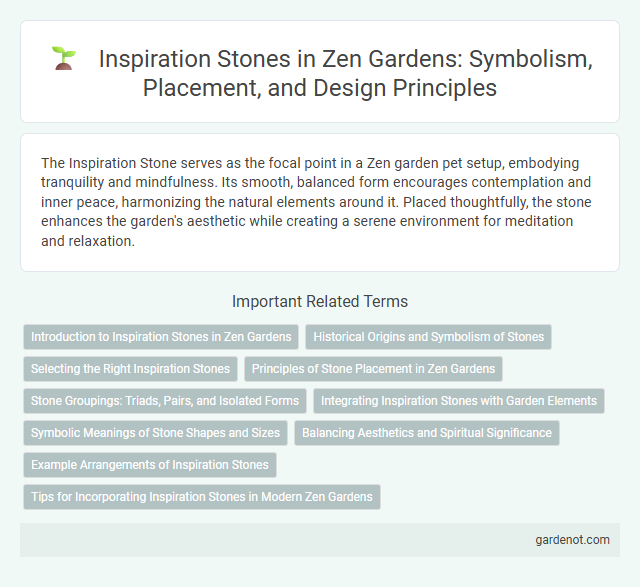The Inspiration Stone serves as the focal point in a Zen garden pet setup, embodying tranquility and mindfulness. Its smooth, balanced form encourages contemplation and inner peace, harmonizing the natural elements around it. Placed thoughtfully, the stone enhances the garden's aesthetic while creating a serene environment for meditation and relaxation.
Introduction to Inspiration Stones in Zen Gardens
Inspiration stones in Zen gardens serve as symbolic focal points, embodying tranquility and natural beauty. These carefully selected rocks represent elements such as mountains, islands, or animals, reinforcing the garden's meditative atmosphere. Their placement follows traditional Zen principles, enhancing mindfulness and spiritual reflection.
Historical Origins and Symbolism of Stones
In Zen gardens, inspiration stones trace their origins to ancient Japanese and Chinese traditions where rocks symbolize elements of nature and spiritual concepts. Historically, these stones represent mountains, islands, or animals, embodying strength, stability, and tranquility. Their placement within the garden follows precise principles to evoke harmony and meditation, reflecting Zen Buddhism's emphasis on mindfulness and the interconnectedness of all things.
Selecting the Right Inspiration Stones
Selecting the right inspiration stones for a Zen garden involves choosing smooth, naturally shaped rocks that evoke a sense of calm and balance. Stones such as granite, basalt, or river stones are ideal for their durability and serene appearance, enhancing the garden's meditative atmosphere. Positioning these stones thoughtfully, often in asymmetrical arrangements, reinforces the garden's symbolic connection to nature and mindfulness.
Principles of Stone Placement in Zen Gardens
The principles of stone placement in Zen gardens emphasize natural arrangement, balance, and symbolism, reflecting harmony between humanity and nature. Stones are strategically positioned to represent mountains, islands, or animals, creating a meditative landscape that encourages mindfulness and contemplation. Careful consideration of size, shape, texture, and space ensures each stone contributes to the garden's overall aesthetic and spiritual purpose.
Stone Groupings: Triads, Pairs, and Isolated Forms
In Zen gardens, stone groupings such as triads, pairs, and isolated forms play a pivotal role in conveying balance, harmony, and natural simplicity. Triads represent completeness and the unity of heaven, earth, and humanity, while pairs emphasize complementary duality and interaction. Isolated stones symbolize solitude and contemplation, creating focal points that enhance the meditative atmosphere of the garden.
Integrating Inspiration Stones with Garden Elements
Integrating inspiration stones into a Zen garden enhances its spiritual and aesthetic harmony by serving as focal points that symbolize strength and tranquility. These stones are carefully positioned among raked gravel, moss, and bamboo to create balanced visual rhythms and encourage meditation. Their natural textures and shapes complement surrounding elements, fostering a cohesive environment that nurtures mindfulness and reflection.
Symbolic Meanings of Stone Shapes and Sizes
In a Zen garden, inspiration stones represent stability and mindfulness through their distinct shapes and sizes. Rounded stones often symbolize harmony and completeness, while angular stones convey strength and resilience. The deliberate placement of varying stone sizes enhances the spiritual balance and contemplative atmosphere essential to Zen garden design.
Balancing Aesthetics and Spiritual Significance
The Inspiration Stone in a Zen garden serves as a focal point that harmonizes aesthetic beauty with deep spiritual meaning, embodying the principles of mindfulness and tranquility. Its carefully chosen shape, texture, and placement create a visual anchor that encourages contemplation and inner balance. This stone symbolizes the union of natural artistry and meditative practice, enhancing the garden's role as a sanctuary for reflection and peace.
Example Arrangements of Inspiration Stones
Inspiration stones in a Zen garden are strategically arranged to evoke tranquility and encourage meditation through their natural shapes and textures. Common example arrangements include grouping three stones to represent earth, water, and sky, or positioning them asymmetrically along raked sand patterns to symbolize balance and harmony. These configurations enhance the garden's aesthetic appeal while embodying Zen principles of simplicity and mindfulness.
Tips for Incorporating Inspiration Stones in Modern Zen Gardens
Incorporate inspiration stones in modern Zen gardens by selecting natural, weathered stones with unique textures and shapes to enhance visual interest and symbolize tranquility. Position stones asymmetrically near water features or gravel patterns to create a focal point that encourages mindfulness and meditation. Maintain simplicity by avoiding overcrowding and allowing space for the stones to convey their symbolic meaning.
Inspiration stone Infographic

 gardenot.com
gardenot.com